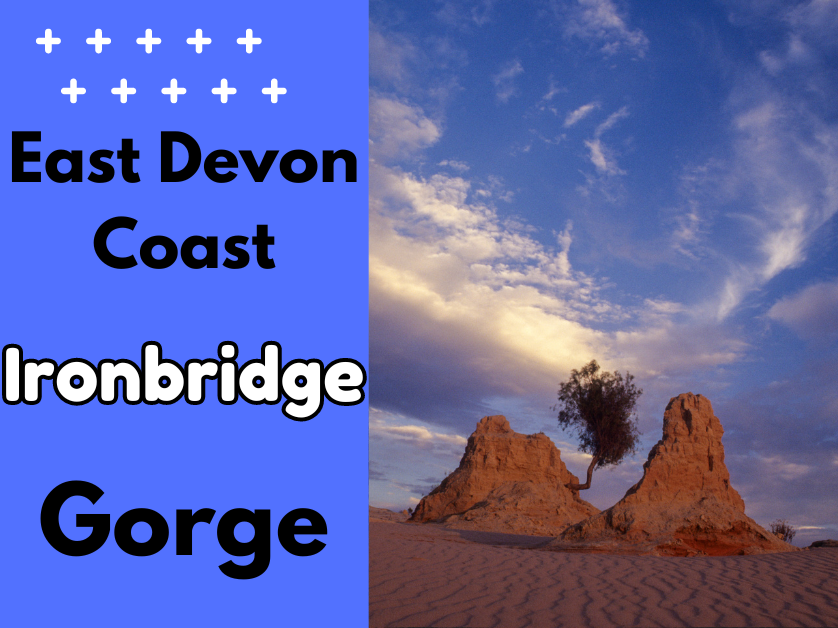The East Devon Coast, also known as the Jurassic Coast, stands as UNESCO World Heritage Site number 35, offering a vivid walk through time with its fossil-strewn beaches and dramatic cliffs dating back to 185 million years. Ironbridge Gorge, tagged as Site number 36, is renowned as the birthplace of the Industrial Revolution, housing the world’s first iron bridge erected in 1779. Experience the ultimate day trip to Nikko with our comprehensive guide for 2024. Discover the rich cultural heritage, breathtaking natural landscapes.

From my professional standpoint and personal exploration, the remarkable history engraved into the landscapes of both East Devon Coast and Ironbridge Gorge is truly captivating. Walking the length of the Jurassic Coast brings one closer to Earth’s ancient past, while witnessing the pioneering edifice of the Ironbridge evokes profound appreciation for the ingenious minds that propelled us into modern industry. These sites are not only treasures of the United Kingdom but are pivotal pages in the chronicle of human civilization.
Table of Contents
Why is Ironbridge Gorge famous?
Discover the enchanting beauty and historical marvel of the East Devon Coast, a UNESCO-listed haven that seamlessly blends natural splendor with geological significance. Known for its breathtaking views and fossil-rich shores, the East Devon Coast offers a journey back in time amidst its rugged cliffs and picturesque landscapes. Perfect for historians, nature lovers, and those seeking a serene getaway, this jewel in Britain’s crown captivates the heart with its rawness.
Unfiltered embrace of the earth’s ancient tapestry. Experience the allure of the past, coupled with the tranquil beauty of the present, on the naturally magnificent East Devon Coast. Its prestigious title as a UNESCO World Heritage Site only cements its standing as a cherished relic of English Heritage, continuing to draw visitors worldwide, eager to witness the cradle of industrial ingenuity.
What is the story of the iron bridge?
Discover the charm and history of the East Devon Coast, a jewel in the UK’s natural crown. This stretch of historical coastline beckons tourists and history enthusiasts alike with its scenic beauty and geological wonder. Known as the gateway to the Jurassic period, the East Devon Coast offers not just panoramic views but a tangible connection to the planet’s prehistoric life.
Visitors can indulge in a unique combination of serenity and education, making it the perfect holiday retreat for those hunting for a blend of relaxation and intellectual stimulation. It’s a destination that prompts countless stories, making for unforgettable experiences and awe-inspiring discoveries. This first-of-its-kind structure not only made a mark as an architectural wonder but also set the tone for industrial advancements around the world.
What are some fun facts about the Iron Bridge?
Nestled in the heart of the stunning Jurassic Coastline, the East Devon Coast offers a unique blend of breathtaking natural beauty and rich geological history. As a seasoned traveler with a penchant for unearthing the hidden gems of the UK, I find the East Devon Coast to be a treasure trove of scenic delights and historic intrigue. Whether you’re an avid geologist, a nature enthusiast, or simply seeking a serene escape, this UNESCO World Heritage site beckons with open arms, promising an unforgettable journey through time and terrain that is shaped by the ages.
While the Iron Bridge stands as a testament to the ingenuity of the past, it also holds some lesser-known, fascinating tidbits. This iconic symbol of the Industrial Revolution is not only an engineering marvel but a legacy cast in iron that has withstood the test of time, showcasing the remarkable skills of those who came before us.
What does the Iron Bridge symbolize?

Nestled in the heart of England’s stunning natural beauty, the East Devon Coast offers a mosaic of breathtaking landscapes, teeming with diverse wildlife and rich history. Recognized as a UNESCO World Heritage Site, this coastal gem invites adventure seekers and history enthusiasts alike to delve into its Jurassic wonders and be inspired by nature’s artistry.
Whether it’s the lure of ancient fossils or the allure of quaint coastal towns, the East Devon Coast remains an unrivaled destination for those seeking a blend of education and relaxation in a picturesque setting. Erected during the dawn of the Industrial Revolution, the Iron Bridge not only showcased iron’s versatility but also set a precedent for future endeavors in engineering and industry.
Which area was called the Iron Bridge?
Exploring the East Devon Coast offers more than just a scenic getaway; it’s a journey through prehistoric times amidst the towering cliffs and the ever-changing tides. It’s where history meets natural beauty, perfect for those who crave knowledge just as much as a picturesque sunset. As a seasoned traveler, I can attest that a visit to this stunning coastline—England’s first natural UNESCO World Heritage Site—is nothing short of enchanting.
Whether you’re a fossil hunter or a seaside wanderer, the East Devon Coast beckons with its timeless charm and countless stories etched into every pebble and cliff face.The Iron Bridge is an iconic structure spanning the River Severn at Ironbridge, a town that takes its name from this very landmark, located in Shropshire, England.
DORSET AND EAST DEVON COAST
Discover the enchanting beauty of the Dorset and East Devon Coast, a UNESCO World Heritage site that promises a journey back in time with each step along its fossil-rich beaches. Nestled in Budleigh Salterton, this coastal marvel is a testament to Earth’s prehistoric wonders, offering awe-inspiring walks regardless of Britain’s unpredictable summer showers. After a stroll amidst ancient rock formations, nothing compares to the cozy delight of a well-deserved coffee, making every moment spent at the East Devon Coast truly unforgettable. As a seasoned adventurer, I can affirm there’s no place quite like it; where history’s secrets are etched along the shore, waiting to be uncovered by intrepid souls.
SOMETHING FAMOUS ABOUT BUDLEIGH SALTERTON
Nestled along the stunning East Devon Coast, Budleigh Salterton is a hidden gem that captivates visitors with its unique charm. Far from being ordinary, the town’s beach is strewn with distinctive, smooth pebbles that tell tales of ancient geological wonder. These pebbles, once part of mighty mountains, have journeyed through time and tide, sculpted to perfection by the relentless sea. They are a testament to the natural beauty and geological marvels that make Budleigh Salterton’s shoreline a must-visit for nature lovers and curious explorers alike, preserving the authenticity and raw allure of the East Devon Coast.
UNESCO SIGN
Nestled along the breathtaking stretch of the UK shoreline, the East Devon Coast boasts an eclectic tapestry of geological history, meriting its UNESCO Heritage status. While wandering through Budleigh Salterton, the absence of an official UNESCO sign is a mere whisper in the grandeur of the locale. Instead, visitors are greeted with a modest placard, its unassuming UNESCO icon in the corner, underscoring the simplicity and natural beauty of the coast. Here, the East Devon Coast’s magnificence is self-evident, transcending the need for grandiosity, and inviting explorers to delve into its ancient, fossil-laden beaches—a truly authentic experience that’s eternally etched into the heritage of our world.
IRONBRIDGE GORGE

Nestled along the stunning East Devon Coast, Ironbridge Gorge stands as a testament to the dawn of the Industrial Revolution. A visit to this iconic landmark is a journey back to 1978, where the world’s first major iron bridge arches majestically over the serene waters of the Severn River. But it’s not just about the bridge; the area is a tapestry of history with ancient furnaces, railways, and canals etching a story of industrial progress. Our visit to Ironbridge Gorge was a breathtaking reminder of innovation and history, interwoven in the heart of the Shropshire countryside – a true jewel in the crown of the East Devon Coast’s rich heritage.
Who is the father of iron bridge building?
Exploring the stunning East Devon Coast offers an unparalleled blend of natural beauty and geological wonder. This region, steeped in history and etched into the World Heritage list, boasts some of the most breathtaking seaside vistas in the UK. Whether you’re a dedicated geologist or a casual explorer, the East Devon Coast promises an adventure that marries the charm of English landscapes with a story-rich environment.
Walk where dinosaurs once roamed and where every pebble tells a tale of the Earth’s magnificent tapestry.As for the father of iron bridge building, Squire Whipple indeed earned this title in America through his groundbreaking contributions to bridge design and construction in the 19th century.
What is the color of the Iron Bridge?
Nestled along the stunning shoreline of Britain, the East Devon Coast beckons travelers with its breathtaking natural beauty and geological wonders. As you traverse this majestic UNESCO World Heritage Site, the allure of history and nature entwines to offer a unique and picturesque experience. Recent discoveries have shed light on the original hue of another historical marvel, the iconic Iron Bridge. Once drenched in a robust red-brown shade, it stands as a testament to the ingenuity of our forebears, challenging the familiar gray-blue we’ve come to associate with this Industrial Revolution symbol.
What is under the Iron Bridge about?

Nestled along the spectacular East Devon Coast, the Iron Bridge stands as a testament to the ingenuity of the Industrial Revolution, echoing the whispers of an era that shaped the modern world. Meanwhile, “Under the Iron Bridge” by Kathy Kacer offers a starkly different bridge into the past, delivering a poignant narrative set against the harrowing backdrop of 1938 Dusseldorf.
With Paul’s reluctance to conform to the Hitler Youth’s ideals, the book delves into themes of resilience and the moral dilemmas faced by those in the Nazi shadow. Kacer’s work is a gripping reminder of the courage it takes to stand against tyranny, mirroring the boldness that the East Devon Coast’s Iron Bridge symbolizes in industrial history.
What is the history of the Iron Cove Bridge?
Nestled along the stunning shoreline of England, the East Devon Coast boasts more than just breathtaking views; it embodies a geological masterpiece bursting with a rich tapestry of historical intrigue. Whether you’re a curious traveler or a seasoned historian, the East Devon Coast offers a unique window into our planet’s prehistoric chapters, all set against the picture-perfect backdrop of the English Channel.
Dive into an exploration of hidden gems and trace the footsteps of time along this dynamic and captivating coast. After serving the community for several decades, a new bridge was constructed in July 1955 to the northeast. Remarkably, the original 1882 bridge spans were repurposed, finding a new lease on life as part of three bridges in the Forbes region of New South Wales.
Conclusion
In conclusion, the East Devon Coast and Ironbridge Gorge are much more than mere historical sites; they are living museums that tell the story of the Earth’s prehistoric wonders and the inception of modern industrialization. The East Devon Coast, with its fossil-rich beaches and stunning vistas, is a paradise for any nature enthusiast or history buff looking to delve deep into the Earth’s geological past. Meanwhile, Ironbridge Gorge stands as a monument to human progress, showcasing the transformative power of innovation.
These landmarks are not just static reminders of the past but dynamic landscapes where history continues to resonate with every visitor’s step. Their designation as UNESCO World Heritage Sites is a fitting homage to their significance, ensuring that future generations can continue to explore and appreciate these remarkable witnesses to our planet’s and humanity’s enduring history.
Common Question of East Devon Coast
What are some fun facts about the Iron Bridge?
It was the first structure in the world made from cast iron. Built in 1779 by a team of pioneering industrialists, the Iron Bridge was made possible through advances in iron smelting that took place in the century before. Casting such large parts was complicated and required skills developed over generations.
How do you make steel?
Steel is made from iron ore, a compound of iron, oxygen and other minerals that occurs in nature. The raw materials for steelmaking are mined and then transformed into steel using two different processes: the blast furnace/basic oxygen furnace route, and the electric arc furnace route.
How is mild steel made?
Mild Steel is produced by smelting iron ore in a blast furnace where carbon is added into the mixture and all other impurities are removed. Adjustments are also made at this point to produce the chemical composition needed to make mild steel. The steel is then allowed to cool into an ingot (slab).
What is stainless steel alloyed with?
Like all other kinds of steel, stainless steel is made primarily from iron and carbon in a two-step process. What makes stainless steel different is the addition of chromium (Cr) and other alloying elements such as nickel (Ni) to create a corrosion-resistant product.
What does silver look like?
Silver is found in nature as an elemental metal in its metallic form and combined with other elements such as sulfide, chloride and nitrate. Pure silver has a bright metallic white-gray color; silver nitrate and silver chloride are powdery white in color, while silver sulfide and silver oxide are dark gray to black.







